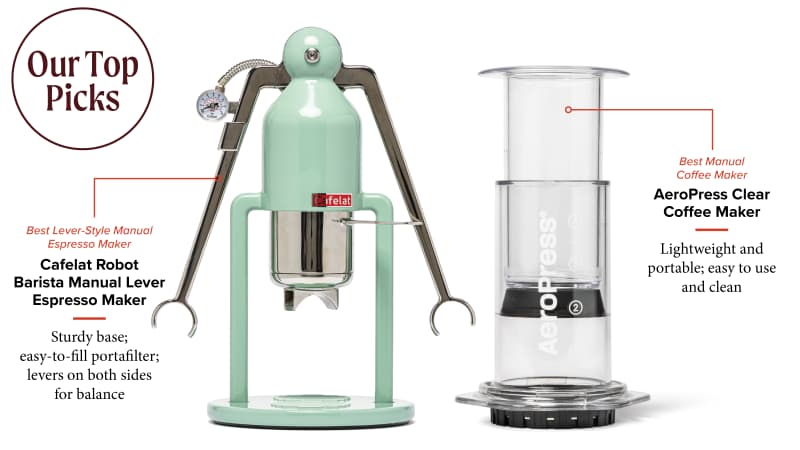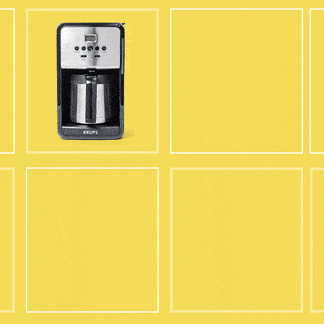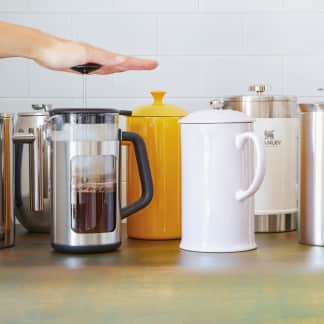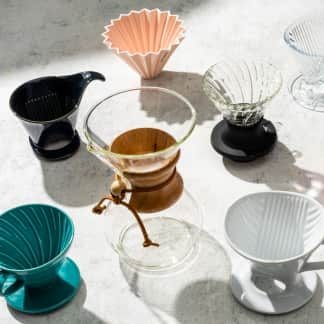The best manual espresso and coffee makers are customizable and consistently produce complex, rich-bodied espresso and nuanced coffee. Our winning manual espresso maker, the Cafelat Robot Barista Manual Lever Espresso Maker, reliably pulls shots of silky and aromatic espresso. If you prefer strong, full-bodied coffee, the AeroPress Clear Coffee Maker is portable, easy to use, and most importantly, brews delicious coffee.

Manual espresso and coffee makers are appealing because they are typically lightweight, compact, and not as pricey as their respective electric versions. They’re also fast, making them ideal for people who don’t want to wait for a machine to warm up. For hobbyists, their customizability is the main draw: From the coffee grind size and brew time to the ratio of coffee to water, people can tinker with variables according to their espresso preferences.

We spent weeks testing the three styles that fall in this category (lever, pump, and AeroPress) and consulted Joe Capatosto, the regional sales and marketing manager of Counter Culture Coffee, for expert feedback. Here’s what we found.
The Different Types of Manual Espresso Makers
Lever-style espresso makers sit on the counter with a cup positioned beneath. Each has a portafilter that contains a brew basket, much like electric espresso machines. You fill the portafilter with a measured amount of finely ground coffee and then tamp it into an even layer. After the portafilter is in place and you’ve added hot water to the device, you press the lever(s), causing pressure to build and move the water quickly through the tightly packed puck of grounds.


Lever-style espresso makers (left) are designed to sit on the counter. Pump-style espresso makers (right) are smaller but must be held aloft while in use.
Pump-style espresso makers are roughly the size of soda cans. Similar to lever-style models, they have a portafilter with a brew basket inside. Each one has a pump on its side that you press repeatedly to generate pressure and produce espresso.

The best lever- and pump-style models can generate 9 or more bars of pressure, which is what the Specialty Coffee Association stipulates in its definition of espresso. That pressure creates sufficient force to brew a shot of full-bodied espresso with beige-colored crema.
What Are AeroPress Coffee Makers?
AeroPress is a popular brand of coffee maker that we’ve tested previously and really liked. The company has introduced new models, and we added them to our testing lineup.
AeroPresses have a brew tube to which you add finely ground coffee and hot water. After giving the mixture a stir, you insert a plunger and press down, forcing the freshly brewed coffee through a filter and into a vessel below. There are two sets of instructions: one for American-style coffee that yields about 10 ounces, and one called “espresso-style” that produces roughly a 2-ounce portion.
There’s confusion about whether either method produces real espresso. The quick answer is no. They don’t generate enough bars of pressure (our testing backed this up). Both the American- and espresso-style batches were weaker than true espresso, according to data we collected on the Total Dissolved Solids (TDS). However, the coffee is excellent in its own right, which along with its portability and espresso-like concentrate earns AeroPress a spot in the conversation.
Which Manual Coffee Maker Is Best?
After weeks of testing we generally cannot recommend pump-style espresso makers. They required so much arm strength that they were too hard to use.
Lever-style espresso makers are the best option for true espresso at home from a manual machine. Just know that you’ll need to tinker with them; small changes to the grind size and volume of water made a big difference in the flavor and texture of the resulting espresso. If the grinds are too coarse, hot water will pass through them too quickly and make underextracted coffee. If they’re too fine, the hot water won’t travel quickly enough, making the coffee taste bitter. To get the most out of your device, you need a burr grinder with multiple extra-fine espresso settings (such as our winner). You can do without multiple settings, but to make the best-tasting coffee and more easily dial in your brew, they’re a big help.
Lastly, we found AeroPresses are best for coffee drinkers who want an affordable coffee maker that’s also portable and easy to stash away.
What to Look For
- Easy-to-Fill Brew Basket or Chamber: We liked models with wide brew baskets and chambers. We also appreciated that some espresso makers came with a dosing cup, a funnel-like tool that sat securely on the brew basket, creating a barrier that prevented grinds from spilling. Some espresso makers had narrow brew baskets and no dosing cups, causing us to spill the grinds and make a mess.

- Sturdy Construction: For lever-style models, we preferred those with a hefty base that stayed stationary during the brewing process. We also liked the models with levers on both sides because they felt more balanced and stable than one-lever models. If a device was designed to sit on top of a mug or brewing vessel, stability was also essential.
- For Espresso Makers, a Wide Metal Tamper: We liked preparing our ground coffee with a sturdy metal tamper, which allowed us to tamp with more authority. We also found some tampers to be narrower than the portafilter, which required more tamps to make the coffee bed even and ensure optimal extraction.
- For Espresso Makers, a Pressure Gauge: We preferred models with pressure gauges (either included or for purchase separately) so that we could monitor the amount of pressure we were generating. This information was crucial to figuring out the optimal grind size and weight to pull a shot of espresso that had a balanced flavor and smooth, silky texture.

What to Avoid
- Pump-Style Manual Espresso Makers: They were difficult to use and clean.

- Lots of Small Parts: Some models had too many small pieces, which became a hassle to track down. We had to be extra-careful when cleaning to keep the pieces from escaping down the drain.
What’s The Difference Between Coffee and Espresso? Ask Paul
Is espresso just strong coffee?- Rickety Bases: We weren’t pleased that some models had lightweight plastic bases. We couldn’t stabilize them and experienced some wobbling back and forth as we exerted pressure.
- Hard-to-Reach Nooks and Crannies: We had trouble cleaning some models because they had small crevices that were impossible to reach. Over time, coffee oils accumulated, creating unpleasant, rancid flavors.
The Tests:
- Pull shots of espresso and brew cups of coffee using manufacturer instructions (for AeroPress, two sets of instructions) and standardized grind size
- Record Total Dissolved Solids (TDS) of the espresso and coffee using a refractometer, which indicates its strength
- Espresso makers only: Dial in the variables to produce an optimal shot of espresso and assess how easy it is to make small adjustments to the brewing process
- Measure the yield of each batch
- Sample espresso and coffee and record tasting notes
- Wash all parts between uses
- Recruit testers of varied experiences to make espresso or coffee from each model
How We Rated
- Performance: We evaluated the quality of the espresso and coffee we brewed, including the flavor and body.
- Ease of Use: We evaluated how comfortable and easy it was to assemble, use, and disassemble each espresso and coffee maker.
- Cleanup: We assessed how easy it was to clean each espresso and coffee maker.



















